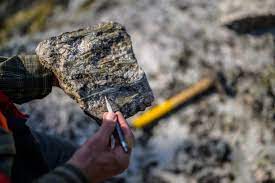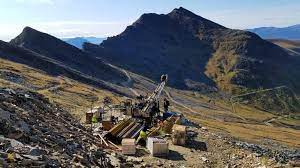Drilling News
175% Increase in Lithium Resource
175% Increase in Lithium Resource
PR Newswire
VANCOUVER, B.C., Sept. 12, 2023
Highlights
1,583,100 tonnes Lithium Carbonate Equivalent (LCE)90% of Resource in Measured CategoryAverage Grade 736 mg/L LiLow Magnesium to Lithium Ratio of 3.27VANCOUVER…

175% Increase in Lithium Resource
PR Newswire
VANCOUVER, B.C., Sept. 12, 2023
Highlights
- 1,583,100 tonnes Lithium Carbonate Equivalent (LCE)
- 90% of Resource in Measured Category
- Average Grade 736 mg/L Li
- Low Magnesium to Lithium Ratio of 3.27
VANCOUVER, B.C., Sept. 12, 2023 /PRNewswire/ —
Lithium South Development Corporation (the “Company”) (TSX-V: LIS) (OTCQB: LISMF) (Frankfurt OGPQ) reports:
With the completion of a 10-hole resource expansion drill program, and evaluation of the results by Groundwater Insight Inc. (GWI) of Halifax, Nova Scotia, Canada, the Company is pleased to announce a 175% increase in the total lithium brine resources at the Hombre Muerto North Lithium Project (HMN Li Project), located in Salta Province, Argentina.
The resource is a combination of the in situ contained lithium at the Alba Sabrina, Natalia Maria, and Tramo claim blocks. The total resource has increased from 571,000 tonnes to 1,583,100 tonnes LCE at an average grade of 736 mg/L lithium with a low average magnesium (a brine contaminant) to lithium ratio of 3.27. The updated lithium resource estimate is summarized by each claim block in the following table, relative to a 500 mg/L cut-off:
Table 1: Lithium South’s updated lithium resource estimate summarized by claim block.
|
Parameter |
Alba Sabrina |
Natalia Maria |
Tramo |
All Sites |
|||
|
Measured |
Indicated |
Total |
Measured |
Measured |
Total |
||
|
Brine Volume (x103 m3) |
|||||||
|
217,900 |
31,700 |
249,600 |
12,900 |
141,600 |
404,100 |
||
|
Average Concentration (mg/L) |
|||||||
|
Lithium |
696 |
712 |
698 |
1,103 |
769 |
736 |
|
|
Tonnage |
|||||||
|
Lithium |
151,700 |
22,600 |
174,200 |
14,200 |
108,900 |
297,400 |
|
|
Lithium Carbonate |
807,300 |
120,200 |
927,500 |
75,800 |
579,800 |
1,583,100 |
|
|
Notes: |
500 mg/L lithium cut-off. Lithium carbonate mass calculated as lithium mass multiplied by the equivalency factor (5.3228). Volume and tonnage numbers are rounded, and may not add up exactly, due to rounding. Mineral resources are not mineral reserves and do not have demonstrated economic viability. |
||||||
Company C.O.O. and Project Manager, Fernando Villarroel is quoted, “We are very pleased with our new updated lithium resource at the HMN Li Project. The quality of the brine has exceeded our expectations.”
Next Steps
A Technical Report is now being completed by GWI and is anticipated to be published within the 45-day requirement. The report will provide details on the resource and project overall.
A pumping well and hydraulic testing program is in progress, to support production wellfield design. In addition, permitting and evaporation test work is in progress.
Company President and C.E.O. Adrian F. C. Hobkirk is quoted, “We are very excited to be able to increase our total LCE resource by such a wide value. With the increase in overall resource, we look forward to developing a larger mining plan.”
Resource Estimate Methodology
The resource estimate was prepared in accordance with the guidelines of National Instrument 43-101 and uses best practice methods specific to brine resources. This approach relies on drilling and sampling methods, utilized during two drilling programs, that yield depth-specific chemistry and Specific Yield measurements of the brine host rock. Dr. Mark King, PhD, FGC, PGeo, of GWI provided technical oversight of the resource estimate.
Data collected during the two drilling programs and used in the mineral resource development included the following:
- Completion of 3695 m of drilling (2849 m of diamond drilling, 45 m of tricone drilling, and 801 m of rotary drilling) in 14 boreholes, which includes:
- Alba Sabrina: 1842 m of diamond drilling in 10 coreholes.
- Natalia Maria: 326 m of diamond drilling in one corehole and 45 m of drilling in one tricone borehole.
- Tramo: 681 m of diamond drilling in two coreholes and 801 m of rotary drilling in two boreholes, completed during the 2018 drilling program.
- The diamond holes were cored with HQ. Samples were collected by packer method, from discrete intervals. Samples were also collected from observation wells constructed after borehole completion, using PVC screen and casing.
- The rotary wells were completed as pumping wells with PVC piping. These wells were pumped for 24-hours to clean and develop prior to sampling.
- A total of 79 core samples were collected from the diamond drillholes and analyzed for Specific Yield.
- A total of 118 brine samples and 46 QAQC samples were collected from the drill holes; and, of these, a total of 88 unique brine samples were used to calculate the resource estimate, including:
- Eighty-six (86) depth-discrete samples were collected from the diamond drill holes during drilling using conventional packer techniques (both single and double packer). One sample was excluded from the resource estimate data set due to suspected contamination.
- 32 composite samples were collected from the wells upon completion of development and/or during pumping tests. Repeat sample locations were averaged, and composite samples from locations with discrete-level samples were excluded from the resource estimation data set, resulting in three unique composite sample locations, representing three long screen wells.
Measured, Indicated, and Inferred Mineral Resource Zones in the current Mineral Resource Estimate were classified based on a borehole spacing method, with semi-variogram analysis used to support minimum borehole spacing. The borehole spacing method is a widely used and industry-accepted approach for resource zone classification.
The resource zone has a total area of 1542 hectares, which includes:
- Alba Sabrina: 1064 hectares;
- Natalia Maria: 95 hectares; and
- Tramo: 383 hectares.
Geological and Resource Models
Geological and Resource models were developed in the numerical modeling software FEFLOW. Geology was interpreted from diamond drilling core and rotary borehole logging within the Alba Sabrina, Natalia Maria, and Tramo claim blocks. Publicly available data were used to support modeling outside of the HMN Li Project properties. Nine geological units were identified within the Alba Sabrina, Natalia Maria, and Tramo claim blocks:
- Interlayered Fine and Coarse Sediments: compact to unconsolidated clay, silt, and sand, including recent alluvial fans, that occur within all three claim areas;
- Interbedded Halite and Sediments: interbedded crystalline to sandy halite, compact to poorly consolidated sand, and compact clay, occurring within the Natalia Maria and Tramo claim blocks;
- Basalt: dark gray basalt flows confined to the Alba Sabrina claim block; the basalt flows range from highly vesicular, to amygdaloidal, to massive, with minor to pervasive fracturing;
- Halite: halite-dominated sequences with interbeds of clastic sediments that occur within the Natalia Maria and Tramo claim blocks;
- Upper Middle Sediments: poorly consolidated to unconsolidated sand within the Alba Sabrina claim block;
- Conglomerate: matrix supported polymictic conglomerate with subangular to subrounded clasts ranging from 2 mm to 15 cm in a silt to medium grained sand matrix occurring in the Tramo claim block;
- Compact Halite: a thick unit of massive, low permeability compact halite with minor clastic layers occurring at depth in the Natalia Maria claim block;
- Brecciated Quartzite: brecciated to pervasively fractured quartzite with clay-rich fracture fill and variable iron staining occurring within the Alba Sabrina claim block; and
- Quartzite: unaltered, low permeability quartzite, interpreted as Paleozoic-aged Falda Ciénaga Formation, that occurs within the Alba Sabrina claim block.
The Compact Halite and Quartzite units are classified as hydrogeological basement for this stage of resource estimation, and do not contribute to the current resource.
A total of 79 core samples collected during the two drilling programs were submitted to GeoSystems Analysis Inc. in Tucson, Arizona, USA to estimate Specific Yield using the Rapid Brine Release (“RBR”) extraction method. The cores were also analyzed for bulk density, total porosity, and field water capacity. The Specific Yield values used for each geological unit in the current resource estimate, the percentage of resource in each unit, and a comparison to the Specific Yield values used for the previous resource are summarized in the following table:
Table 2: Specific Yield values for the current resource and comparison with the previous 2018 resource.
|
Current Mineral Resource Estimate |
% change |
Previous Resource |
||||
|
Geological Unit |
% of Resource |
# of samples |
Specific Yield (%) |
2018 Specific Yield (%) |
2018 Geological Unit (Tramo) |
|
|
Interlayered Fine and Coarse Sediments – Alba Sabrina |
15.1 |
24 |
11.1 |
|||
|
Interlayered Fine and Coarse Sediments – Natalia Maria & Tramo |
7.9 |
8 |
8.9 |
-1 % |
9.0 |
Interlayered clastic sediments |
|
Interbedded Halite and Sediments |
17.9 |
10 |
9.6 |
-4 % |
10.0 |
Interbedded halite and sediments |
|
Basalt |
3.6 |
6 |
5.3 |
|||
|
Halite |
3.7 |
5 |
6.8 |
|||
|
Upper Middle Sediments |
18.5 |
14 |
13.1 |
|||
|
Conglomerate |
11.9 |
5 |
8.7 |
0 % |
8.7 |
Conglomerate |
|
Brecciated Quartzite |
21.4 |
5 |
8.6 |
|||
|
Total |
79 |
|||||
The brine data were interpolated using an Ordinary Kriging method directly within FEFLOW. In addition to the 88 unique brine sample locations, brine data from publicly available data sets were used to inform the brine grade outside of the HMN Li Project properties. These outside values provide a more fulsome view of brine chemistry in the salar at large but have minimal influence in the interpolated grades on the HMN Li Project claims.
Brine Sample Analysis and QAQC
The brine samples collected during the recent (2022-23) drilling program were analyzed at Alex Stewart International (ASI) in Mendoza, Argentina. ASI is an ISO 9001:2008 and ISO14001:2004 accredited laboratory.
Brine samples were analyzed with the following methodologies: ICP-OES (inductively-couple plasma-optical (atomic) emission spectrometry) to quantify boron, barium, calcium, iron, lithium, magnesium, manganese, potassium, sodium, and strontium; an argentometric method to assay for chloride; a gravimetric method to analyze for sulfate and total dissolved solids; a volumetric analysis for the evaluation of alkalinity; and a pycnometer to determine density.
A systematic Quality Assurance and Quality Control program included the following: A reference sample was inserted into the sample stream at a frequency of approximately 1 in 10 samples; a low-range reference sample (essentially a field blank) was inserted at a frequency of approximately 1 in 10 samples; and a field duplicate sample was inserted into the sample stream at a frequency of approximately 1 in 10 samples. In addition, a program of laboratory duplicate sampling was conducted by ASI; and two sets of independent field duplicate samples were collected by the QP.
Dr. Mark King, PhD, FGC, PGeo, of Groundwater Insight, Inc., is the qualified person (QP) for this work, as such term is defined by NI 43-101. Dr. King has extensive experience in salar environments and has been a QP on numerous lithium brine projects, ranging from early exploration to production. Dr. King is independent from the Company and has reviewed and approved the technical information mentioned in this press release. A Technical Report prepared in accordance with NI 43-101 in support of the resource estimate will be filed on SEDAR (www.sedarplus.ca) and on the Company’s website (www.lithiumsouth.com) within 45 days.
About Lithium South
Lithium South (LIS) owns 100% of the Hombre Muerto North Lithium Project (HMN Li Project) located in Salta and Catamarca Provinces, Argentina, the heart of the lithium triangle. The Hombre Muerto Salar has a history of lithium production, with Livent Corporation in operation for over twenty-five years, in an area just south of the HMN Li Project. The HMN Li Project is surrounded by a US$4 billion lithium development under construction by POSCO (Korea) and the Sal de Vida Project under development by Allkem. LIS has delineated a NI 43-101 compliant 1,583,100 tonne Lithium Carbonate Equivalent (LCE) resource on the Alba Sabrina, Natalia Maria, and Tramo, claim blocks, three of five non-contiguous blocks that make up the HMN Li Project. LIS is now transitioning from being a lithium explorer to becoming a lithium developer.
On behalf of the Board of Directors
Adrian F. C. Hobkirk
President and Chief Executive Officer
Investors / Shareholders call 1-855-415-8100 / website: www.lithiumsouth.com
Neither the TSX Venture Exchange nor its Regulation Services Provider (as that term is defined in policies of the TSX Venture Exchange) accepts responsibility for the adequacy or accuracy of this release. The TSX Venture Exchange has not reviewed the content of this news release and therefore does not accept responsibility or liability for the adequacy or accuracy of the contents of this news release.
This news release contains certain “forward-looking statements” within the meaning of Section 21E of the United States Securities and Exchange Act of 1934, as amended. Except for statements of historical fact relating to the Company, certain information contained herein constitute forward-looking statements. Forward-looking statements are based upon opinions and estimates of management at the date the statements are made and are subject to a variety of risks and uncertainties and other factors which could cause actual results to differ materially from those projected in the forward-looking statements. The reader is cautioned not to place undue reliance on forward- looking statements. We seek safe harbor.
View original content:https://www.prnewswire.com/news-releases/175-increase-in-lithium-resource-301924255.html
SOURCE Lithium South Development Corporation
drilling
drill program
tsxv-lis
lithium-south-development-corporation
lithium south development corporation
press-release

Valhalla Metals reports 21 metres of 6.84% CuEq at Sun Project, Alaska
Valhalla Metals Inc. [TSXV-VMXX; OTCQB-VMXXF] reported assay results from four diamond drill holes totaling 1,104…
Capella Announces Definitive Agreement for the Sale of is Central Norway Copper-Cobalt Projects to NickelX and Financing Update
Capella Announces Definitive Agreement for the Sale of is Central Norway Copper-Cobalt Projects to NickelX and Financing Update
Canada NewsWire
VANCOUVER, BC, Oct. 17, 2023
VANCOUVER, BC, Oct. 17, 2023 /CNW/ – Capella Minerals Ltd (TSXV: CMIL) (OTC…
Canada Silver Cobalt Works Confirms Pegmatites up to 20 meters wide and 70 meters long at Sangster West
Pegmatite Confirmations and Advanced Geochemical Insights Propel Exploration Success
Coquitlam, BC – TheNewswire – October 17, 2023 – Canada Silver…

















